Moisture Absorption/Desorption Effects on Flexural Property of Glass-Fiber-Reinforced Polyester Laminates: Three-Point Bending Test and Coupled Hygro-Mechanical Finite Element Analysis
Abstract
:1. Introduction
2. Experiment
3. Results and Discussion
4. Coupled Hygro-Mechanical FE Analysis
5. Conclusions
- (1)
- For GFRP laminates tested at 20 °C, the E-modulus and flexural strength of moisture saturated GFRP laminates dropped 15.6% and 35.4% respectively, comparing with the fully dry materials. While, the difference of E-modulus and flexural strength between absorption process and desorption process was very limited.
- (2)
- For GFRP laminates tested at 40 °C, the E-modulus and flexural strength of moisture saturated GFRP laminates dropped 17.1% and 42.9% respectively, comparing with the fully dry materials. There were significant unrecoverable losses of E-modulus (15.0%) and flexural strength (16.4%) for the GFRP laminates experienced both moisture absorption and desorption process.
- (3)
- Experimental results confirmed that the combination of moisture and temperature seriously deteriorated the flexural properties of GFRP laminates, on both strength and stiffness.
- (4)
- Predictive equations for environment-dependent flexural properties of FRP laminates were obtained by using the least square method for the curve fitting. These predictive equations can be employed as the input parameters for a coupled hygro-mechanical FE model, as well as a contribution to the design code as far as the long-term performance of FRP structures is concerned.
- (5)
- A coupled hygro-mechanical FE modeling method was developed to analyze the environment-dependent mechanical behaviours of FRP laminates, and was validated by the experimental results of flexural tests. In the following research works, it could be employed in the parametric FE analysis, and predict the environment-dependent behaviours of other material tests or FRP structures.
Acknowledgments
Author Contributions
Conflicts of Interest
References
- Knippers, J.; Pelke, E.; Gabler, M.; Berger, D. Bridges with Glass Fibre-Reinforced Polymer Decks: The Road Bridge in Friedberg, Germany. Struct. Eng. Int. 2010, 20, 400–404. [Google Scholar] [CrossRef]
- Luke, S.; Canning, L.; Collins, S.; Knudsen, E.; Brown, P.; Taljsten, B.; Olofsson, I. Advanced composite bridge decking system—project ASSET. Struct. Eng. Int. 2002, 12, 76–79. [Google Scholar] [CrossRef]
- Alampalli, S.; Kunin, J. Rehabilitation and field testing of an FRP bridge deck on a truss bridge. Compos. Struct. 2002, 57, 373–375. [Google Scholar] [CrossRef]
- Schollmayer, M. Through-Thickness Performance of Adhesive Connections Between FRP Bridge Decks and Steel Main Girders; Ecole Polytechnique Federale de Lausanne: Lausanne, Switzerland, 2009. [Google Scholar]
- Gurtler, H.W. Composite Action of FRP Bridge Decks Adhesively Bonded to Steel Main Girders Lausanne; Ecole Polytechnique Federale de Lausanne: Lausanne, Switzerland, 2004. [Google Scholar]
- Keller, T.; Bai, Y.; Vallee, T. Long-term performance of a glass fiber-reinforced polymer truss bridge. J. Compos. Constr. 2007, 11, 99–108. [Google Scholar] [CrossRef]
- Chen, A.; Davalos, J.F. Strength evaluations of sinusoidal core for FRP sandwich bridge deck panels. Compos. Struct. 2010, 92, 1561–1573. [Google Scholar] [CrossRef]
- Hollaway, L.C. A review of the present and future utilisation of FRP composites in the civil infrastructure with reference to their important in-service properties. Constr. Build. Mater. 2010, 24, 2419–2445. [Google Scholar] [CrossRef]
- Shao, Y.X.; Kouadi, S. Durability of fiberglass composite sheet piles in water. J. Compos. Constr. 2002, 6, 280–287. [Google Scholar] [CrossRef]
- Bank, L.C.; Gentry, T.R.; Barkatt, A. Accelerated Test Methods to Determine the Long-Term Behavior of Frp Composite Structures–Environmental-Effects. J. Reinf. Plast. Compos. 1995, 14, 559–587. [Google Scholar]
- Nogueira, P.; Ramirez, C.; Torres, A.; Abad, M.J.; Cano, J.; Lopez, J.; Barral, L. Effect of water sorption on the structure and mechanical properties of an epoxy resin system. J. Appl. Polym. Sci. 2001, 80, 71–80. [Google Scholar] [CrossRef]
- Earl, J.S.; Shenoi, R.A. Hygrothermal ageing effects on FRP laminate and structural foam materials. Compos. Part A-Appl. Sci. Manuf. 2004, 35, 1237–1247. [Google Scholar] [CrossRef]
- Robert, M.; Roy, R.; Benmokrane, B. Environmental Effects on Glass Fiber Reinforced Polypropylene Thermoplastic Composite Laminate for Structural Applications. Polym. Compos. 2010, 31, 604–611. [Google Scholar] [CrossRef]
- Karbhari, V.M. E-glass/vinylester composites in aqueous environments: Effects on short-beam shear strength. J. Compos. Constr. 2004, 8, 148–156. [Google Scholar] [CrossRef]
- Daly, H.B.; Brahim, H.B.; Hfaied, N.; Harchay, M.; Boukhili, R. Investigation of water absorption in pultruded composites containing fillers and low profile additives. Polym. Compos. 2007, 28, 355–364. [Google Scholar] [CrossRef]
- Karbhari, V.M.; Xian, G.J. Hygrothermal effects on high V(F) pultruded unidirectional carbon/epoxy composites: Moisture uptake. Compos. Part B-Eng. 2009, 40, 41–49. [Google Scholar] [CrossRef]
- Dell’Anno, G.; Lees, R. Effect of water immersion on the interlaminar and flexural performance of low cost liquid resin infused carbon fabric composites. Compos. Part B-Eng. 2012, 43, 1368–1373. [Google Scholar] [CrossRef] [Green Version]
- Springer, G.S. Enivormental Effects on Composite Materials, Vol.1; Technomic Pubnishing Company: Lancaster, PA, USA, 1981. [Google Scholar]
- Springer, G.S. Enivormental Effects on Composite Materials, Vol.2; Technomic Pubnishing Company: Lancaster, PA, USA, 1984. [Google Scholar]
- Springer, G.S. Enivormental Effects on Composite Materials, Vol.3; Technomic Pubnishing Company: Lancaster, PA, USA, 1987. [Google Scholar]
- Loh, W.K.; Crocombe, A.D.; Wahab, M.M.A.; Ashcroft, I.A. Modelling anomalous moisture uptake, swelling and thermal characteristics of a rubber toughened epoxy adhesive. Int. J. Adhes. Adhes. 2005, 25, 1–12. [Google Scholar] [CrossRef]
- Haque, A.; Mahmood, S.; Walker, L.; Jeelani, S. Moisture and Temperature Induced Degradation in Tensile Properties of Kevlar Graphite Epoxy Hybrid Composites. J. Reinf. Plast. Compos. 1991, 10, 132–145. [Google Scholar] [CrossRef]
- Akay, M.; Mun, S.K.A.; Stanley, A. Influence of moisture on the thermal and mechanical properties of autoclaved and oven-cured Kevlar-49/epoxy laminates. Compos. Sci. Technol. 1997, 57, 565–571. [Google Scholar] [CrossRef]
- Eslami, S.; Honarbakhsh-Raouf, A.; Eslami, S. Effects of moisture absorption on degradation of E-glass fiber reinforced Vinyl Ester composite pipes and modelling of transient moisture diffusion using finite element analysis. Corros. Sci. 2015, 90, 168–175. [Google Scholar] [CrossRef]
- Carra, G.; Carvelli, V. Long-term bending performance and service life prediction of pultruded Glass Fibre Reinforced Polymer composites. Compos. Struct. 2015, 127, 308–315. [Google Scholar] [CrossRef]
- Silva, M.A.G.; da Fonseca, B.S.; Biscaia, H. On estimates of durability of FRP based on accelerated tests. Compos. Struct. 2014, 116, 377–387. [Google Scholar] [CrossRef]
- Standard Test Methods for Flexural Properties of Unreinforced and Reinforced Plastics and Electrical Insulating Materials; D790–10 A; ASTM International: Philadelphia, PA, USA, 2010.
- Jiang, X.; Kolstein, H.; Bijlaard, F.; Qiang, X.H. Effects of hygrothermal aging on glass-fibre reinforced polymer laminates and adhesive of FRP composite bridge: Moisture diffusion characteristics. Compos. Part A-Appl. Sci. Manuf. 2014, 57, 49–58. [Google Scholar] [CrossRef]
- Gellert, E.P.; Turley, D.M. Seawater immersion ageing of glass-fibre reinforced polymer laminates for marine applications. Compos. Part A-Appl. Sci. Manuf. 1999, 30, 1259–1265. [Google Scholar] [CrossRef]
- Grammatikos, S.A.; Evernden, M.; Mitchels, J.; Zafari, B.; Mottramd, J.T.; Papanicolaou, G.C. On the response to hygrothermal aging of pultruded FRPs used in the civil engineering sector. Mater. Des. 2016, 96, 283–295. [Google Scholar] [CrossRef] [Green Version]
- Joliff, Y.; Belec, L.; Heman, M.B.; Chailan, J.F. Experimental, analytical and numerical study of water diffusion in unidirectional composite materials–interphase impact. Comput. Mater. Sci. 2012, 64, 141–145. [Google Scholar] [CrossRef]
- Ashcroft, I.A.; Hughes, D.J.; Shaw, S.J.; Wahab, M.A.; Crocombe, A. Effect of temperature on the quasi-static strength and fatigue resistance of bonded composite double lap joints. J. Adhes. 2001, 75, 61–88. [Google Scholar] [CrossRef]
- Ashcroft, I.A.; Wahab, M.M.A.; Crocombe, A.D.; Hughes, D.T.; Shaw, S.J. The effect of environment on the fatigue of bonded composite joints. Part 1: Testing and fractography. Compos. Part A-Appl. Sci. Manuf. 2001, 32, 45–58. [Google Scholar] [CrossRef]
- Zhou, J.M.; Lucas, J.P. The effects of a water environment on anomalous absorption behavior in graphite-epoxy composites. Compos. Sci. Technol. 1995, 53, 57–64. [Google Scholar] [CrossRef]
- Barjastech, E.; Nutt, S.R. Moisture absorption of unidirectional hybrid composites. Compos. Part A-Appl. Sci Manuf. 2012, 43, 158–164. [Google Scholar] [CrossRef]
- Muliana, A.; Nair, A.; Khan, K.A.; Wagner, S. Characterization of thermo-mechanical and long-term behaviors of multi-layered composite materials. Compos. Sci. Technol. 2006, 66, 2907–2924. [Google Scholar] [CrossRef]
- Davies, P.; Evrard, G. Accelerated ageing of polyurethanes for marine applications. Polym. Degrad. Stab. 2007, 92, 1455–1464. [Google Scholar] [CrossRef]
- Moulzakis, D.E.; Zoga, H.; Galiotis, C. Accelerated environmental ageing study of polyester/glass fiber reinforced composites (GFRPCs). Compos. Part B-Eng. 2008, 39, 467–475. [Google Scholar] [CrossRef]
- Crocombe, A.D.; Ashcroft, I.A. Abdel Wahab MM. Chapter 8 Environmental Degradation. Modeling of Adhesively Bonded Joints; Springer-Verlag: Berlin, Germany, 2008. [Google Scholar]
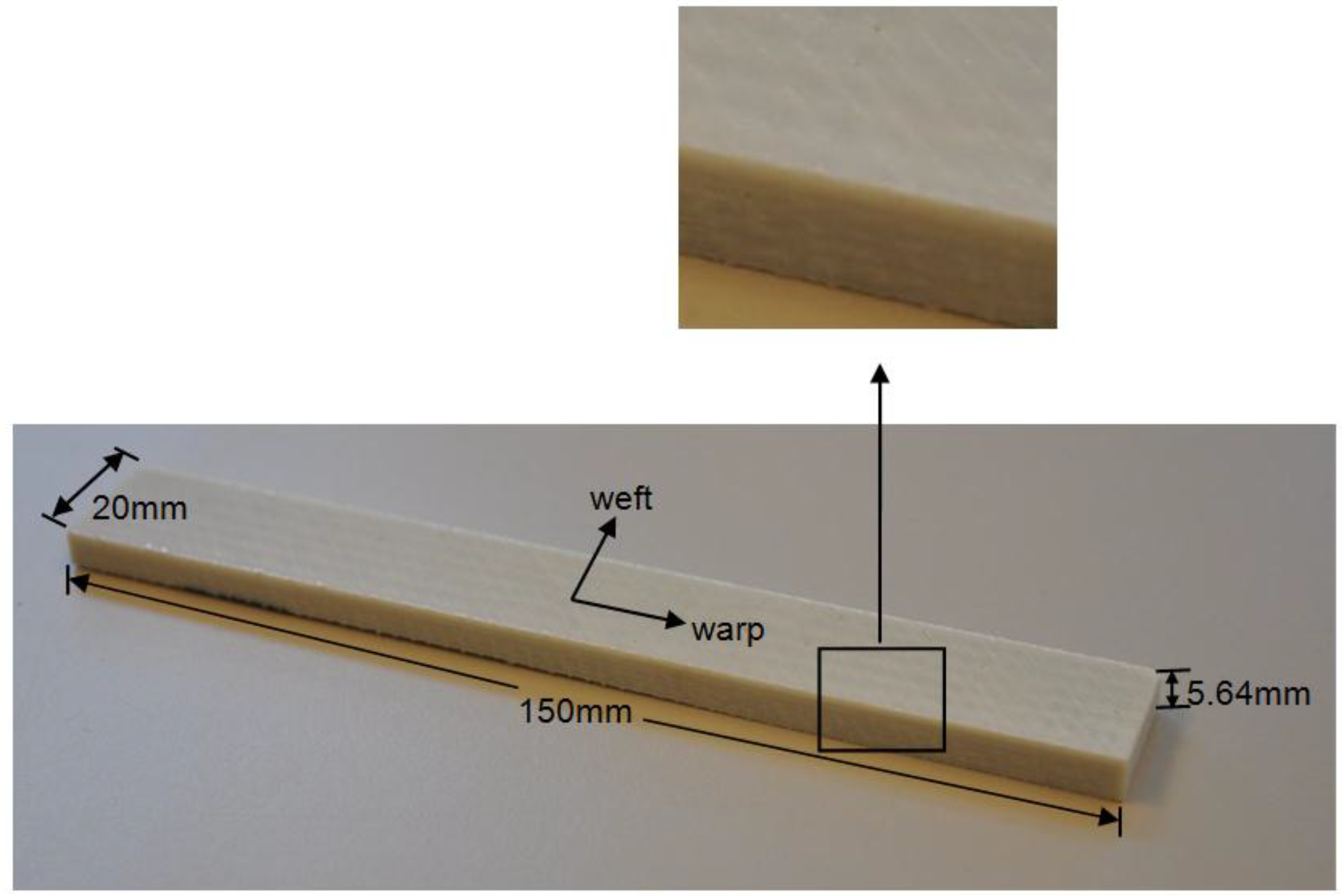
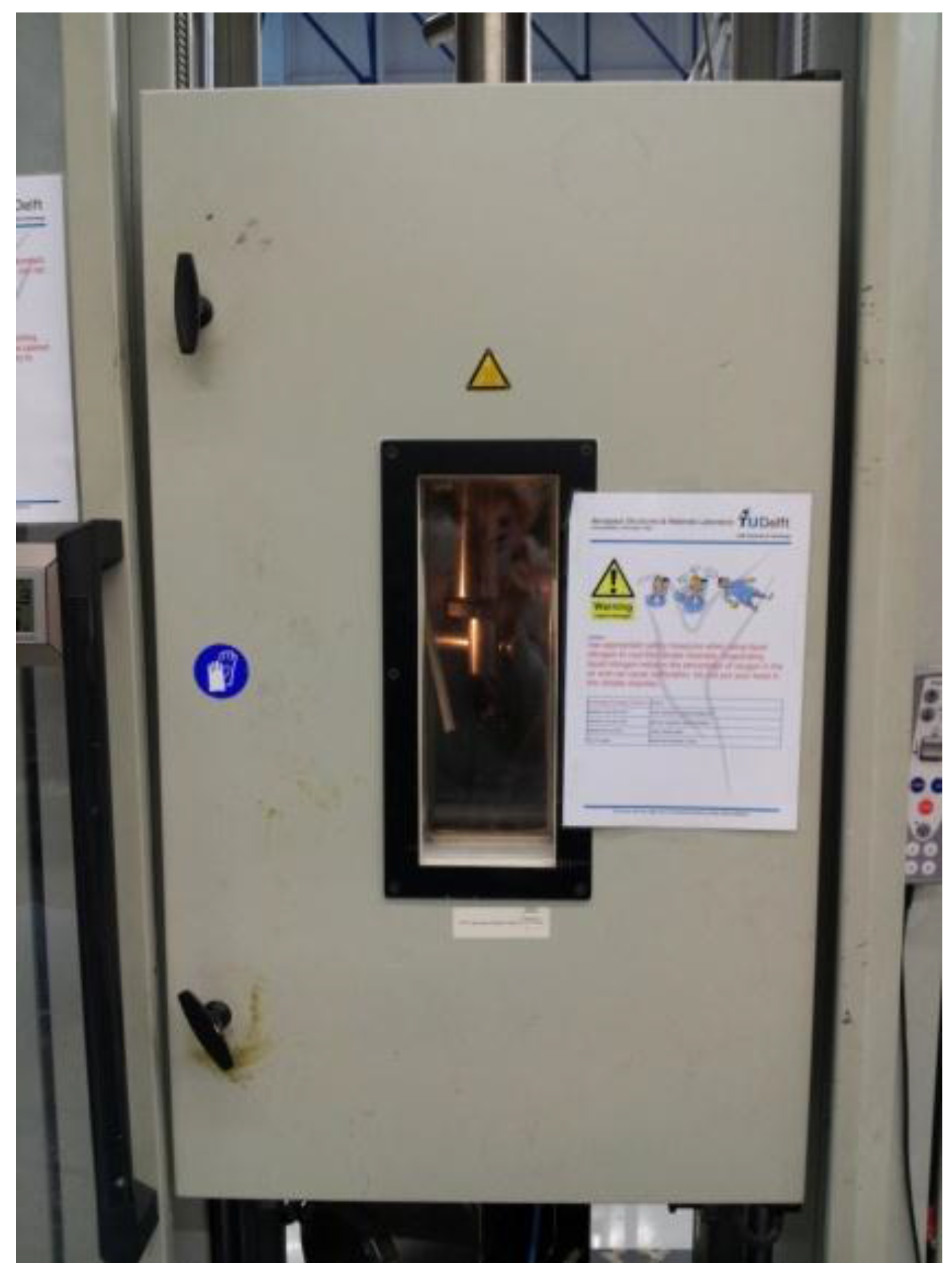
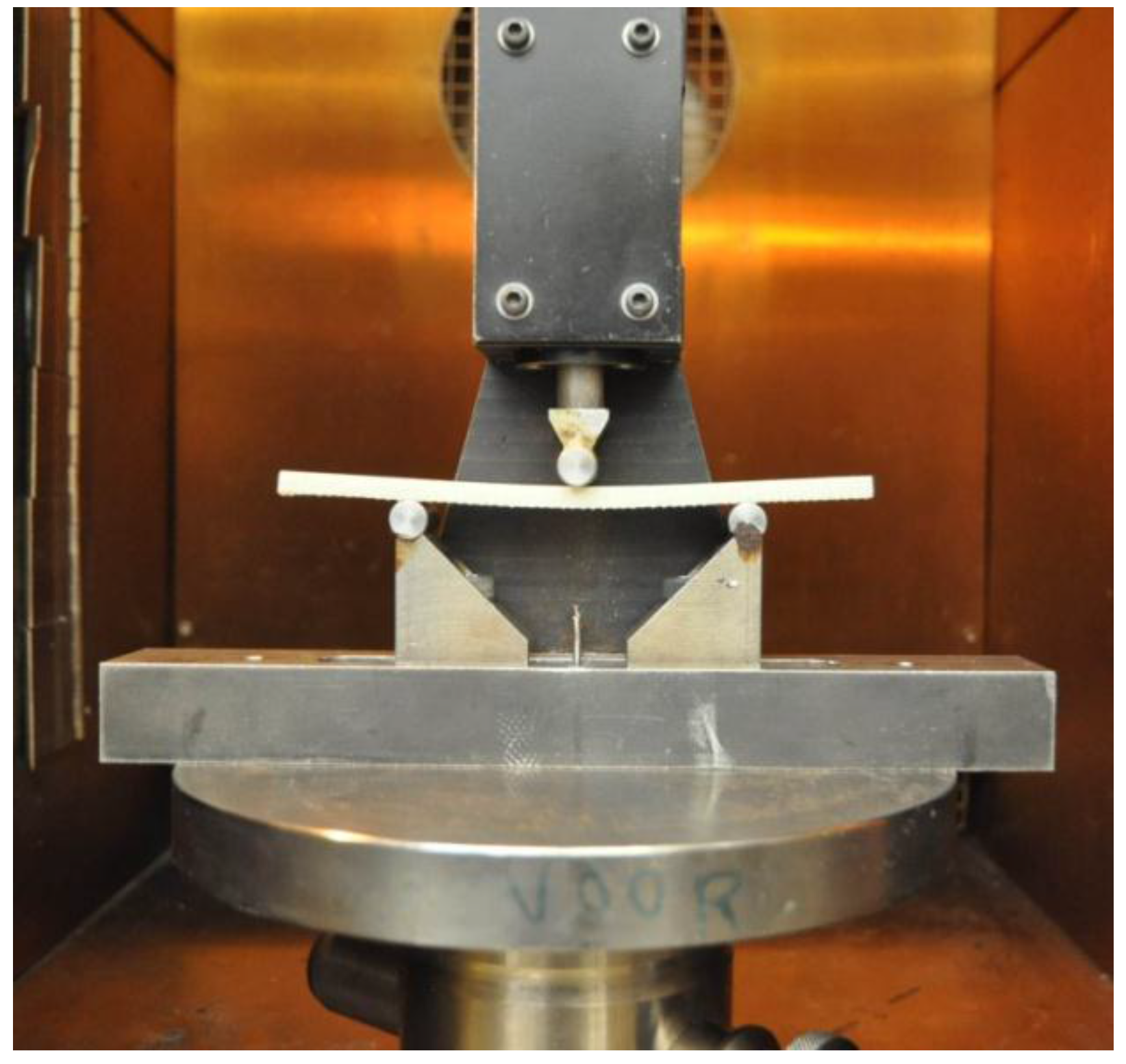



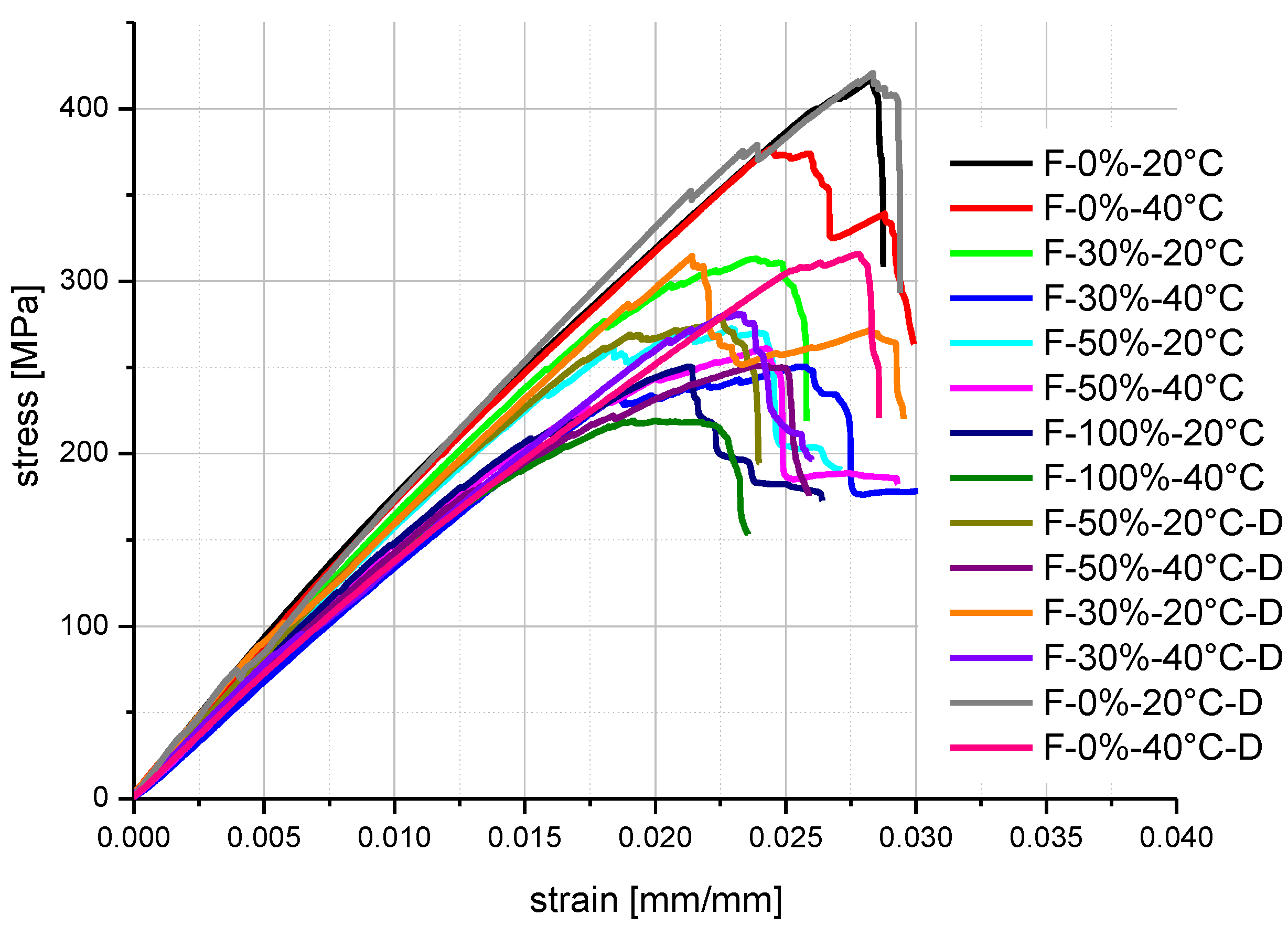



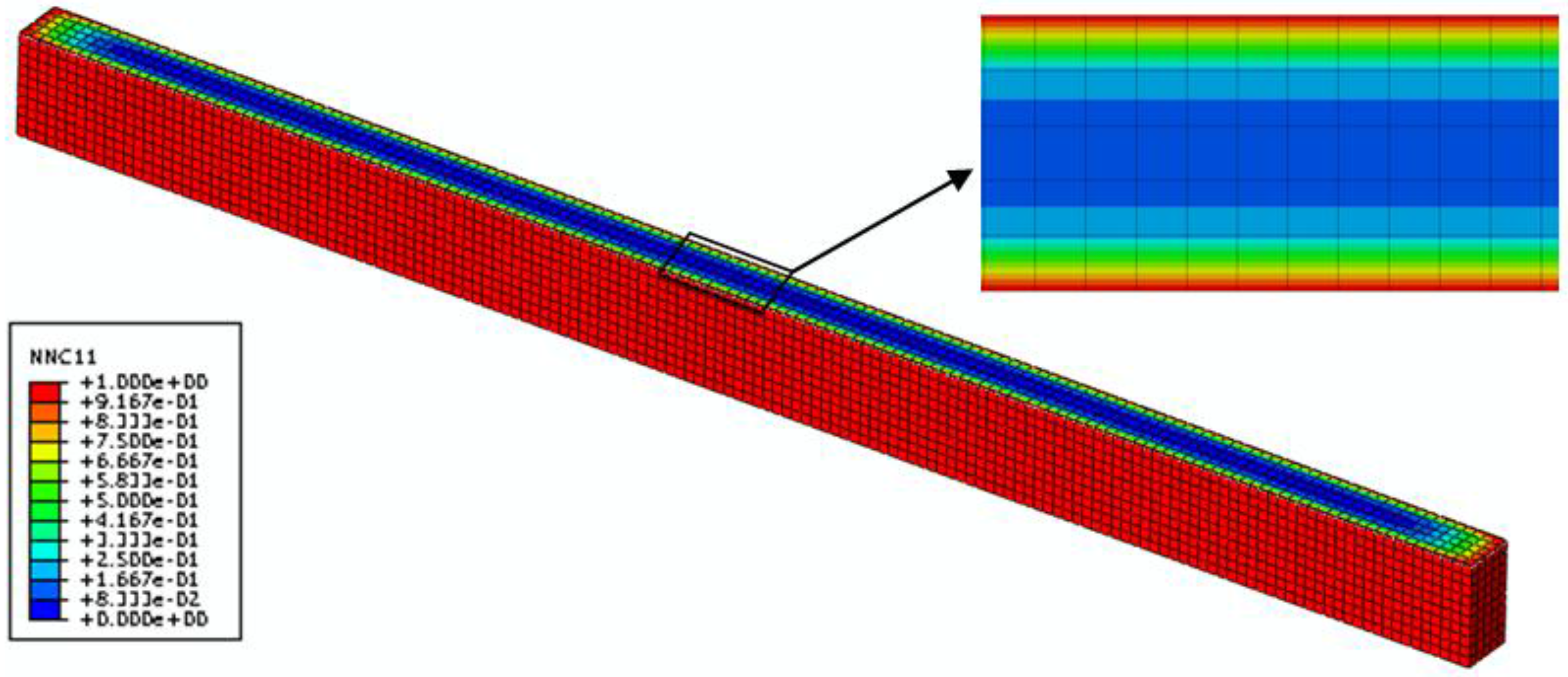
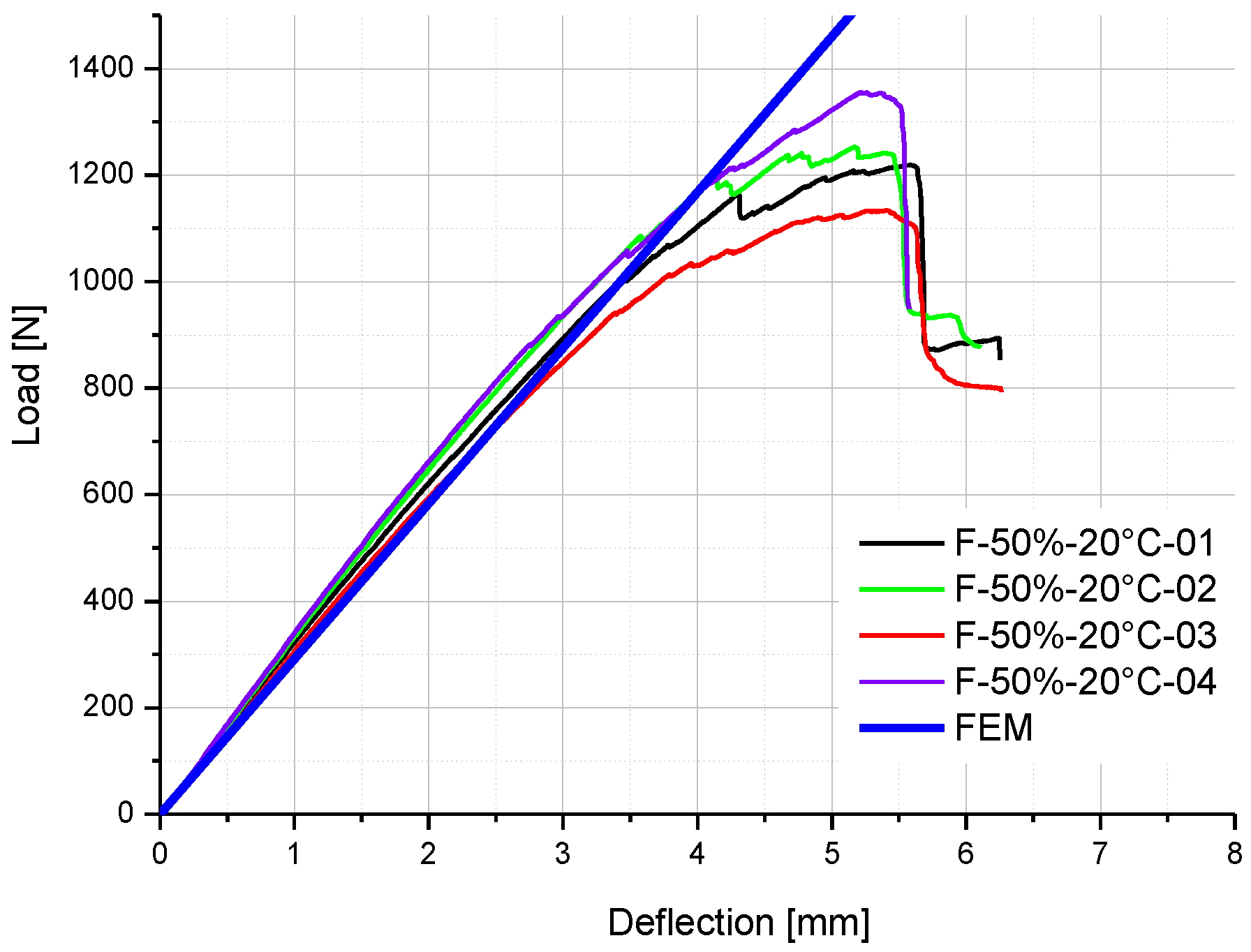
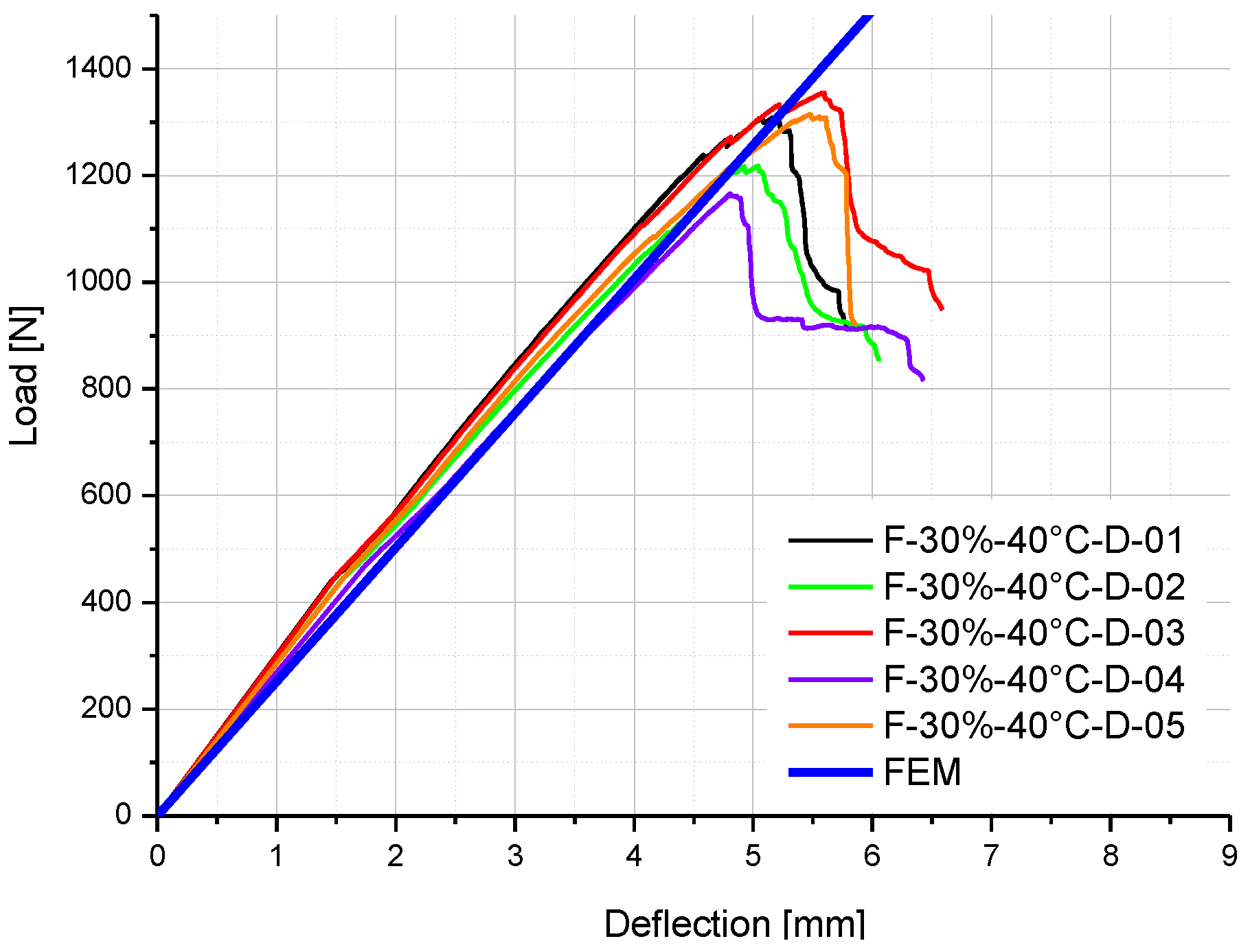
| Product name | Total weight (g/m2) | Weight uniformity (g/m2) | ||||
|---|---|---|---|---|---|---|
| Yarn roving | Knit yarn | |||||
| 0° (Warp) | +45° | 90° (Weft) | −45° | |||
| EQX 1200 | 1,193 | 283 | 300 | 300 | 300 | 10 |
| Property | Tensile (ISO 527-4) | Compression (ISO 8515) | Flexural (ISO 14.125) | |||
|---|---|---|---|---|---|---|
| Mean value | Warp | Weft | Warp | Weft | Warp | Weft |
| Strength | 331 MPa | 314 MPa | 220 MPa | 200 MPa | 473 MPa | 433 MPa |
| Modulus | 18 GPa | 17 GPa | 14 GPa | 14 GPa | 13 GPa | 11 GPa |
| Specimen identification | Test | Mt/M∞ | Test temperature | After desorption | Numder of specimens | |
|---|---|---|---|---|---|---|
| Set-1 | F-0%-20 °C | flexural | 0 | 20 °C | no | 5 |
| F-0%-40 °C | flexural | 0 | 40 °C | no | 5 | |
| Set-2 | F-30%-20 °C | flexural | 30% | 20 °C | no | 5 |
| F-30%-40 °C | flexural | 30% | 40 °C | no | 5 | |
| Set-3 | F-50%-20 °C | flexural | 50% | 20 °C | no | 5 |
| F-50%-40 °C | flexural | 50% | 40 °C | no | 5 | |
| Set-4 | F-100%-20 °C | flexural | 100% | 20 °C | no | 5 |
| F-100%-40 °C | flexural | 100% | 40 °C | no | 5 | |
| Set-5 | F-50%-20 °C-D | flexural | 50% | 20 °C | yes | 5 |
| F-50%-40 °C-D | flexural | 50% | 40 °C | yes | 5 | |
| Set-6 | F-30%-20 °C-D | flexural | 30% | 20 °C | yes | 5 |
| F-30%-40 °C-D | flexural | 30% | 40 °C | yes | 5 | |
| Set-7 | F-0%-20 °C-D | flexural | 0 | 20 °C | yes | 5 |
| F-0%-40 °C-D | flexural | 0 | 40 °C | yes | 5 | |
| Specimen identification | E-Modulus * (MPa) | Standard deviation (MPa) | Flexural strength * (MPa) | Standard deviation (MPa) |
|---|---|---|---|---|
| F-0%-20 °C | 16,609 | 386 | 411 | 6.89 |
| F-0%-40 °C | 15,409 | 852 | 375 | 8.49 |
| F-30%-20 °C | 15,873 | 867 | 299 | 8.88 |
| F-30%-40 °C | 13,874 | 500 | 249 | 11.42 |
| F-50%-20 °C | 15,038 | 710 | 269 | 17.03 |
| F-50%-40 °C | 13,870 | 535 | 252 | 17.57 |
| F-100%-20 °C | 14,022 | 514 | 265 | 13.74 |
| F-100%-40 °C | 12,780 | 538 | 214 | 6.08 |
| F-50%-20 °C-D | 14,408 | 551 | 260 | 15.46 |
| F-50%-40 °C-D | 13,019 | 832 | 239 | 17.85 |
| F-30%-20 °C-D | 15,059 | 740 | 324 | 37.04 |
| F-30%-40 °C-D | 12,336 | 166 | 277 | 9.85 |
| F-0%-20 °C-D | 16,333 | 204 | 410 | 10.80 |
| F-0%-40 °C-D | 13,095 | 698 | 314 | 13.92 |
© 2016 by the authors. Licensee MDPI, Basel, Switzerland. This article is an open access article distributed under the terms and conditions of the Creative Commons Attribution (CC-BY) license ( http://creativecommons.org/licenses/by/4.0/).
Share and Cite
Jiang, X.; Song, J.; Qiang, X.; Kolstein, H.; Bijlaard, F. Moisture Absorption/Desorption Effects on Flexural Property of Glass-Fiber-Reinforced Polyester Laminates: Three-Point Bending Test and Coupled Hygro-Mechanical Finite Element Analysis. Polymers 2016, 8, 290. https://doi.org/10.3390/polym8080290
Jiang X, Song J, Qiang X, Kolstein H, Bijlaard F. Moisture Absorption/Desorption Effects on Flexural Property of Glass-Fiber-Reinforced Polyester Laminates: Three-Point Bending Test and Coupled Hygro-Mechanical Finite Element Analysis. Polymers. 2016; 8(8):290. https://doi.org/10.3390/polym8080290
Chicago/Turabian StyleJiang, Xu, Jie Song, Xuhong Qiang, Henk Kolstein, and Frans Bijlaard. 2016. "Moisture Absorption/Desorption Effects on Flexural Property of Glass-Fiber-Reinforced Polyester Laminates: Three-Point Bending Test and Coupled Hygro-Mechanical Finite Element Analysis" Polymers 8, no. 8: 290. https://doi.org/10.3390/polym8080290






